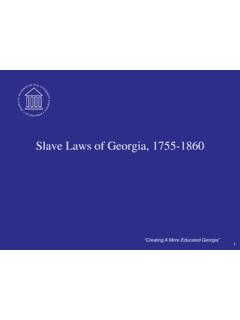Transcription of Georgia Militia Districts
1 Georgia Militia Districts By Alex M. Hitz [Reprinted from Georgia Bar Journal, Vol. 18, No. 3 (February, 1956), and published with the permission of the Georgia Bar Association.] The active, organized Georgia Militia , in the sense that it existed during the Revolutionary War, the War of 1812 and the various Indian uprisings until 1840, is today practically extinct. Its place was taken by the Volunteer organizations, both before and after the War Between the States, and later by the National Guard when it was organized in 1916. In fact, although detailed provisions for the government of the organized Georgia Militia were contained in the 1863 Code, later Codes dropped all but a few references to it although containing equivalent provisions relating to the Volunteers.
2 The 1910 Code omitted all references to the Militia as a military force. It is true that the Act of Aug. 21, 1916 (Chap 86-2 of the 1933 Code) and the Act of Feb. 19, 1951 (Chap. 86-1 of the 1933 Code Supplement ) contain references to the unorganized Militia , but it is obvious that they are included only to provide for a reservoir of manpower who could be made subject to the draft and duty in the defense of the State in emergencies of the gravest nature. Technically, every citizen of the State, between the ages of 17 and 45, who is not a member of the National Guard or other organized military force, is today a member of the unorganized Georgia Militia in the Militia District in which he resides.
3 But although the organized Georgia Militia is dead, the Georgia Militia Districts are very much alive and enter daily into the activities of all of our citizens in anything connected with (1) the territorial jurisdiction of Justice of the Peace Courts; (2) the boundaries of election Districts ; (3) the return of property for taxation; (4) stock and fence laws; (5) the conveyancing of land in headright Counties; and (6) in all other circumstances specifically referred to in the laws of the Senate as presently codified. It must be borne in mind that , as was stated by Chief Justice Fish in the case reported in 150 Ga 370 ( ), " it clearly appears ** that Captain s and Company Districts were the same as what are now known as Militia Districts .
4 " The words Captain s, Company and Militia appear interchangeably in all of the legislation where Militia District is the subject or is referred to. Militia Districts had their origin in the colonial Acts of Jan. 24, 17551 and Sept. 29, 1773,2 and the basic principles were adopted and adapted in all subsequent enactments of the State Legislature. Originally the Provincial Governor, as Commander in Chief, was empowered to create Regimental and Company Districts and the field officers commissioned by him would define the lines of the King s Militia Company Districts and designate the number of men constituting the Militia company in that District.
5 The Captain of each Company would enroll the names of every male, between the ages of 16 and 60, residing in the Company District, and his action automatically made those men members of that Militia Company. The first Militia Act of the newly-formed State was passed on Nov. 15, Practically the only changes from the Colonial Acts were in the lowering of the minimum age to 15 years and the election of the Captain and Lieutenants by the Militiamen residing in that Company District. The Act of Feb. 26, 1784,4 passed at the close of the Revolutionary War to amend the 1778 Act, placed the age limits between 16 and 50, but still made the enrolling of the names of all residents in a Company District, by the Captain thereof, an automatic and compulsory enlistment.
6 Under both Acts the boundaries of each Company District were determined by the Governor and Commander in Chief and were controlled by the number of militiamen residing therein, a Company being limited to a maximum of sixty-three men. It was under these Acts that there was originated the custom of identifying the District in which the Company was contained by the name of the Captain of that Company. Thus, with each election of a Captain, the same Militia Company District could be known successively as Smith s District, Jones District, Brown s District or Robinson s District.
7 The name of a Georgia Militia Company and of the District in which the Company was located changed each time its Captain died, resigned or was removed, and it then became known as the District of his successor. Following the passage, on May 8, 1792,5 of the Act of Congress establishing uniform Militia laws for all of the States, Georgia again revised and amended her former Militia laws by her act of Dec. 14 (or 24), The only new revisions, so far as the Militia Companies and Militia Districts were effected, called for elections of Captains in all Company Districts "within ten days after such Company District shall have been defined by the Executive.
8 " Governor Telfair issued a proclamation on Dec. 21, 17927 to the effect that the Company Districts "will remain as at present established." The appointment of a Adjutant General was first provided for by this Act. The amending Act of Feb. 18,17998 gave to the field officers of each Regiment the power to arrange and define Company Districts , subject to the approval of the Brigade Commander. No act can be found, dated prior to 1807, which required that Captain s or Company Districts should be numbered. Up to and including April 8, 1804 no commission issued to a Company officer mentioned the name of his Company, but all commissions issued on or after May 2, 1804 designated the number of the Company District for which issued.
9 Presumably the numbering of Militia Districts or Captain s Districts originated as a regulation of the Adjutant General, but it was soon after written into the laws by the Act of Dec. 10, Sect. 4 of that Act read: "Every division, brigade, regiment, battalion and company district shall be numbered throughout the State, by order of the commander in chief, in such manner that every corps of the same denomination shall bear a different number, by which numbers every district shall be designated in the commissions of officers commanding therein." Prior to the passage of the 1807 Act, the Adjutant General had given numbers to 275 Militia Districts or Company Districts , all in twenty-six headright Counties, and as each new County was thereafter formed and Militia Districts were designated therein, they were likewise numbered in consecutive order.
10 The highest numbered Militia District is 1892. In the course of time 281 Districts have been abolished through consolidation or otherwise, but those losses have been somewhat offset by clerical errors in duplicating 54 numbers, so that there are approximately 1665 Militia Districts in the State, as of 1955. As new Counties were formed from older Counties or large tracts were transferred from one County to another, the Militia Districts retained their identities and numbers thus, Long County which was created in 1920 contains Militia Districts Nos. 16 and 24 which had been numbered in 1804 when part of Liberty County.




